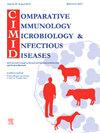Primarily molecular detection and phylogenetic analyses of spotted fever group Rickettsia species in cats in Türkiye: With new host reports of Rickettsia aeschlimannii, Rickettsia slovaca, and Candidatus Rickettsia barbariae
IF 2
3区 农林科学
Q4 IMMUNOLOGY
Comparative Immunology Microbiology and Infectious Diseases
Pub Date : 2025-02-06
DOI:10.1016/j.cimid.2025.102319
引用次数: 0
Abstract
Domestic cats are companion animals that live with people in their households or outdoors, and strong relationships exist between cats and humans. However, this animal is also a host/reservoir of zoonotic pathogens, including Rickettsia species. In Türkiye, cat ownership has increased over the years, but there is a lack of data on the pathogens in cats. In this study, 396 cat blood samples were collected from different parts of Türkiye, and these samples were investigated for Rickettsia species with PCR assay. In addition, DNA sequences were performed for species identification and phylogenetic analyses of detected Rickettsia species. 24 out of 396 cat blood samples (6.06 %) were found to be infected with Rickettsia species. The DNA sequence analyses of all PCR-positive samples were done, and Ri. aeschlimannii was identified in 17 samples, Ri. slovaca in four, Candidatus Rickettsia barbariae in two, and Ri. raoultii in one sample. The phylogenetic analyses of obtained DNA from the above-mentioned species were performed. The sequence data belonging to the species were uploaded to the GenBank, and accession numbers for Rickettsia aeschlimannii (PP998242-PP998258), Ri. slovaca (PP998259-PP998262), Candidatus Rickettsia barbariae (PP998263-PP998264), and Ri. raoultii (PP998265) were taken. This result provides the first molecular detection of Ri. aeschlimannii, Ri. slovaca, Candidatus Rickettsia barbariae, and Ri. raoultii in Türkiye. Moreover, the DNA of Ri. aeschlimannii, Ri. slovaca, and Candidatus Rickettsia barbariae were identified in cat blood samples for the first time in the world, and the cats were a new host for these Rickettsia species. Detailed studies are, however, needed to determine the pathogenicity, biological characteristics, and vectors of these Rickettsia species in this new host.
家猫是一种伴侣动物,与人一起生活在家里或户外,猫和人之间存在着牢固的关系。然而,这种动物也是人畜共患病原体的宿主/宿主,包括立克次体。在泰国,养猫的人数近年来有所增加,但缺乏关于猫身上病原体的数据。本研究采集了396份猫立克次体(rkiye)不同部位的血液样本,采用PCR法检测立克次体的种类。此外,对检测到的立克次体进行了物种鉴定和系统发育分析。在396份猫血样本中发现24份(6.06 %)感染立克次体。对所有pcr阳性样本进行DNA序列分析,Ri。在17份样品中鉴定出埃氏曼氏菌。4个是斯洛伐克菌,2个是野蛮立克次体候选菌,Ri。Raoultii在一个样本中。对上述物种获得的DNA进行了系统发育分析。将该种属的序列数据上传到GenBank,埃氏立克次体(pp998242 ~ pp998258), Ri;(PP998259-PP998262), (PP998263-PP998264);取raoultii (PP998265)。这一结果首次提供了Ri的分子检测。aeschlimannii, Ri。野蛮立克次体候选菌和李氏菌。raoultii in trkiye。此外,Ri的DNA。aeschlimannii, Ri。猫血标本中首次检出了slovaca、Candidatus rickettia barbariia,猫是这两种立克次体的新宿主。然而,需要进行详细的研究来确定这些立克次体物种在这个新宿主中的致病性、生物学特性和媒介。
本文章由计算机程序翻译,如有差异,请以英文原文为准。
求助全文
约1分钟内获得全文
求助全文
来源期刊
CiteScore
4.60
自引率
0.00%
发文量
102
审稿时长
40 days
期刊介绍:
Comparative Immunology, Microbiology & Infectious Diseases aims to respond to the concept of "One Medicine" and to provide a venue for scientific exchange. Based on the concept of "Comparative Medicine" interdisciplinary cooperation between specialists in human and animal medicine is of mutual interest and benefit. Therefore, there is need to combine the respective interest of physicians, veterinarians and other health professionals for comparative studies relevant to either human or animal medicine .
The journal is open to subjects of common interest related to the immunology, immunopathology, microbiology, parasitology and epidemiology of human and animal infectious diseases, especially zoonotic infections, and animal models of human infectious diseases. The role of environmental factors in disease emergence is emphasized. CIMID is mainly focusing on applied veterinary and human medicine rather than on fundamental experimental research.

 求助内容:
求助内容: 应助结果提醒方式:
应助结果提醒方式:


